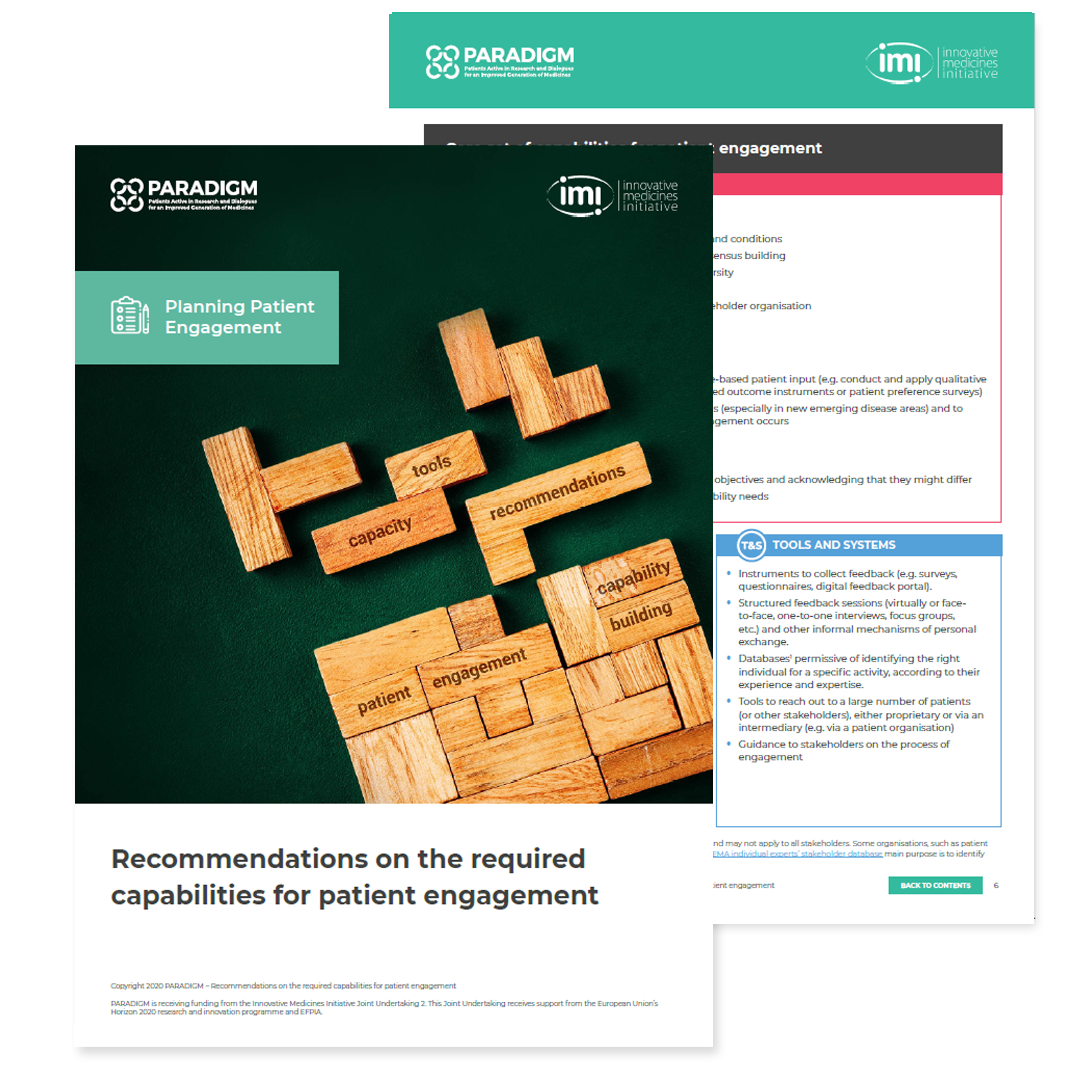
Recommendations on the required capabilities for patient engagement
Background/Rationale for the document
This tool provides recommendations on the competencies (understood as knowledge, skills and behaviours) and resources that each stakeholder organisation should aspire to have in place in order to plan, implement and evaluate meaningful and sustainable patient engagement (PE) activities across the medicines lifecycle.
Objective of the tool
The objective of the recommendations is to increase preparedness of stakeholder organisations by identifying the capabilities required by those individuals involved in implementing PE activities and the resources (processes, tools and systems, organisational structure) needed within the organisation. This tool does not address the specific competencies of the patient participants involved in PE activities.
Summary of the content
This tool shows the key themes identified for effective PE and describes the identified capabilities required under each theme including:
1. Shared purpose and roles and responsibilities of all stakeholders
2. Respect and accessibility
3. Representativeness of all stakeholders
4. Transparency in communication and documentation:
- legal agreements and confidentiality
- management of competing interests
- codes of conduct and rules of engagement and
- reach-out to and interact with patients and patient organisations
5. Continuity and sustainability
- financial compensation and
- measuring PE impact
6. What to consider when engaging with potentially vulnerable populations
Key message
Each stakeholder can use these recommendations to analyse their own organisation’s capabilities at a given moment and consider the elements described in this tool to further develop or adapt the capability model existing in their own organisations.
Methodology
A literature search of patient engagement (PE) frameworks in the three decision-making points relevant to PARADIGM to look for ‘capabilities’ was performed using PubMed. Search terms included: “patient engagement”, “patient and public involvement”, “medicines research and development”, “drug development”, “clinical trial design”, “clinical research”, “study design”, “health technology assessment”, “research agenda setting”, “framework”, “regulatory”. Google scholar was also used to look for articles within the education and business domains with search terms such as “business capabilities” and “organisational capabilities”. A review of grey literature, as well as cross-fertilisation between project work packages, allowed to identify additional resources.
Considering that PE in medicines development involves different stakeholder groups coming together in a collaborative partnership via their respective organisations, we decided to focus both on the competencies required by the individuals directly involved in implementing PE activities and the resources required within the organisation. For-profit organisations have developed the concept of business capabilities as a central part of enterprise architecture[1],[2],[3],[4],[5]. It was agreed to adapt the following definition of a business capability model: ’a capability model describes the complete set of capabilities an organisation requires to execute or fulfill its core mission’4 .The definition of business capability from the webinar “Putting Business Capabilities to Work”5 was adapted to develop a modified business capability model consisting of four main pillars: 1) competencies (knowledge, skills and behaviours), 2) processes, 3) tools and systems and 4) organisation (i.e. organisational structure). Adaptability and transferability were also considered as two additional overarching components that reflect the reality of the current PE ecosystem in terms of constant adaptation and refinement (of processes and practices) and the needs of learning exchanges both within and across stakeholder organisations. The modified business model framework was overlaid onto the existing Patient-Focused Development (PFMD)Patient Engagement Quality Guidance[6], used as an underlying framework to divide, where appropriate, the present document into sections that would cover the most relevant aspects of PE in medicines development.
To populate the capability framework an authoring group was defined. This group was further divided into smaller sub-groups that undertook the writing and review of the different sections. Sub-groups were balanced in terms of stakeholder representation and were asked to reach out to missing stakeholders. An open review cycle was triggered after a section(s) was finalized. Editorial meetings were used to reach consensus on the content for each of the sections at key time points in the drafting of the deliverable. A first draft of the recommendations was also reviewed by the PILG. After that, a face-to-face WP4 workshop was held to validate the contents of the recommendations. The resulting version was sent for consultation to the whole PARADIGM consortium and PILG members. A public consultation was also conducted.
[1] Schienstock, g. Organizational capabilities: some reflections on the concept. IAREG Working Paper. Deliverable 1.2. Research Unit for Technology, Science and Innovation Studies. University of Tampere. April 2009
[2] Knight G, Cavusgil S. Innovation, organisational capabilities, and the born-global firm. J Int Bus Stud. 2004, 35:124
[3] Ángeles M, Göttling-Oliveira-Monteiro S, Vázquez-Rodríguez P. (2015). Organisational Capabilities and Profitability: The Mediating Role of Business Strategy. SAGE Open. doi.org/10.1177/2158244015616852
[4] Business capability definition from the webinar “Putting Business Capabilities to Work” hosted by the Object Management Group, a non-profit technology standards consortium, 15 Jan 2014. https://www.omg.org/news/member-news/OMG-Putting-Cap-To-Work.pdf
[5] Business Process Incubator. Accessed on 11 Nov 2018 https://www.businessprocessincubator.com/content/ability-capability-capacity-and-competence/
[6] Patient-Focused Medicines Development. Patient Engagement Management Suite. https://patientfocusedmedicine.org/pem-suite/. Last accessed 26 Aug 2020
Contributors
| Main authors Elisa Ferrer (EURORDIS-Rare Diseases Europe) Virginie Hivert (EURORDIS-Rare Diseases Europe) |
|
| Contributors Wolf See (BAYER) Karina Huberman (EATG) Giorgio Barbareschi (EATG) Tamás Bereczky (EATG) Giulio Maria Corbelli (EATG) Stuart Faulkner (Oxford University) Ana Díaz (Alzheimer Europe) Anne Claire Julienne (Servier) Ingrid Klingmann (Ethics Expert Panel/EFGCP) Chi Pakarinen (The Synergist) Nicholas Brooke (The Synergist) Walter Atzori (Alexion) |
Camilla Habre (EPF) Valentina Strammiello (EPF) Pietro Erba (AIFA) Begonya Nafría (Fundació Sant Joan de Déu) María José Vicente Edo (IACS) Lucía Prieto (IACS) Kay Warner (GSK) Laura Cappellari (GSK) Julieth Mojica (Novo Nordisk) Lukas Eichmann (Novo Nordisk) Sheuli Porkess (ABPIA) Kirsty Reid (EFPIA) |
| Coordination Karina Huberman (EATG) Wolf See (Bayer) Ingrid Klingmann (EFGCP) |
Editorial committee Stuart Faulkner (Oxford University) Michaela Dinboeck (Novartis) |


